If there’s one thing that defines Bhutanese cuisine, it’s the love for chillies! In Bhutan, chillies aren’t just a seasoning—they’re a staple vegetable. That’s why traditional Bhutanese dishes are generously spiced with dried or fresh red and green chillies, adding a fiery kick to every meal.
No trip to Bhutan is complete without trying the country’s beloved national dish, Ema Datshi—a rich, comforting blend of Ema (chilli) and Datshi (cheese). As the name suggests, this iconic dish is a perfect harmony of spice and creaminess, making it a true taste of Bhutan.
Not a fan of spicy food? No worries! Bhutanese locals understand that their spice levels can be intense for some visitors. Simply let your guide know in advance, and they’ll arrange for your meals to be prepared with a milder touch.
Want a taste of Bhutan at home? Here’s a quick one-minute video on how to cook the classic Ema Datshi (Chilli Cheese). Enjoy!
This recipe has inspired numerous variations, including Kewa Datshi (potato and cheese) and Shamu Datshi (mushroom and cheese), each offering its own unique twist on Bhutan’s beloved cheesy delight.
Red rice, a highly nutritious staple similar to brown rice, is the heart of most Bhutanese meals. Once cooked, it takes on a pale pink hue, with a soft, slightly sticky texture. Meals are typically served with one or two side dishes, featuring either meat or vegetables. Pork, beef, and chicken are commonly enjoyed, while popular vegetables include spinach, pumpkins, turnips, radishes, tomatoes, riverweed, onions, and green beans.
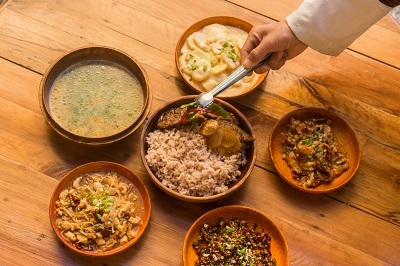
If you find yourself in Bumthang, central Bhutan, you’ll notice a shift in the staple food—buckwheat pancakes and noodles take centre stage, replacing rice as the local favourite.
Bhutanese Cuisine
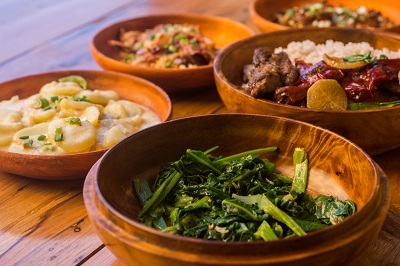
Bhutanese cuisine is deeply influenced by Chinese, Tibetan, and Indian culinary traditions. Don’t be surprised if you’re served mountains of rice—a staple in almost every meal. While white rice is common, the more nutritious red rice is also widely consumed.
If you enjoy Chinese food, you’re likely to appreciate Bhutanese cuisine, as they share similar flavours and ingredients. Another key element in Bhutanese cooking is cheese. Given Bhutan’s high-altitude, cold climate, and the prevalence of livestock farming—cows, yaks, sheep, and goats—dairy products, especially cheese, feature in most dishes, even in their teas!
One of Bhutan’s most beloved drinks is Suja (butter tea), a rich, savoury beverage enjoyed by locals, especially in colder months. It’s often paired with zaw (roasted rice) for breakfast, though some prefer starting their day with a warm bowl of porridge.
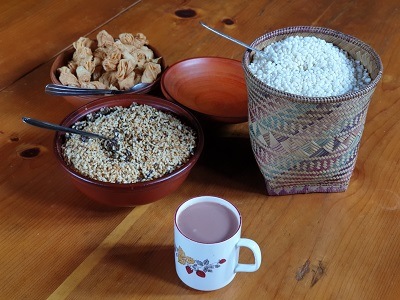
Dining Out in Bhutan
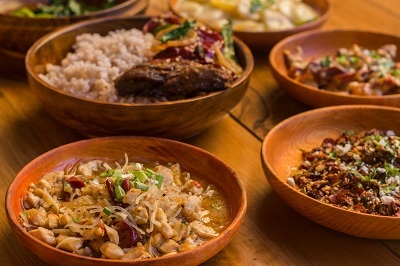
No need to worry if you’re not a fan of spicy food—most professional chefs in Bhutan are mindful of international visitors and can adjust the spice levels to suit your taste.
While Bhutanese cuisine is a highlight, most restaurants also offer a variety of dishes, ranging from Continental and Chinese to Tibetan and Indian cuisine. Though international fare is somewhat limited, many hotels serve buffet-style dinners, featuring a mix of flavours to cater to different palates.
As a predominantly Buddhist country, Bhutan offers a good variety of vegetarian dishes, though many are generously spiced with chillies and enriched with cheese sauce. Traditional vegetarian meals often feature unique local ingredients such as nettles, fern fronds, orchids, asparagus, taro, and various types of mushrooms.
For vegans, it's best to check in advance, as many dishes may contain cheese or eggs. When ordering, simply ask whether a dish is dairy- or egg-free to ensure it aligns with your dietary preferences.
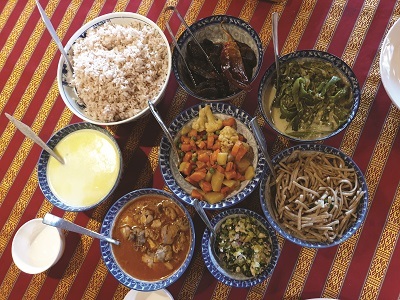
Tap Water in Bhutan
Food in Bhutan is generally clean and safe for consumption, with no significant reports of food poisoning among tourists. However, tap water is not recommended for drinking, especially if you have a sensitive stomach. To stay safe, stick to bottled water, which is widely available and affordable.
Bhutan’s agro-industry produces excellent bottled spring water, and a 1-litre bottle costs only 20 BTN (around 0.30 USD). If you’re unsure about water safety, always opt for sealed bottled water or use boiled or filtered water during your stay.
How much does food cost in Bhutan?
Dining out at an average Bhutanese restaurant typically costs between 320 BTN (5 USD) and 2,000 BTN (32 USD) per person, depending on the restaurant and meal choice.
For those who enjoy a drink, a 0.5-litre bottle of local beer is priced between 80 BTN (1.25 USD) and 250 BTN (3.60 USD), making it an affordable option to complement your meal.
Where to go for food & drinks in Bhutan?
You’ll find the highest concentration of restaurants in Thimphu (the capital), Paro, and the southern town of Phuentsholing, offering a range of local and international cuisine.
In Thimphu, a must-try is Ngad-ja, a sweet milk tea commonly served in a teapot alongside snacks. For the more adventurous, there’s Suja (butter tea)—a savoury drink made with butter and salt. While it has a soup-like consistency, it’s surprisingly flavourful and perfect for warming up on chilly days.
If you're interested in local drinks, try Ara, a traditional Bhutanese liquor distilled from rice, barley, or wheat. For those who enjoy alcohol, locally brewed beers and whiskeys are also widely available.
6 Popular Beverages to Enjoy in Bhutan
Most Popular Cafes in Thimphu
Coffee Culture : Located in the heart of Thimphu, Coffee Culture is a popular café known for its consistency in both food and drinks. Offering an international menu, it serves everything from rich coffees to filling meals, making it a favourite spot for both locals and visitors. Its central location and welcoming atmosphere make it an ideal place for casual dining, work meetings, or a relaxing coffee break.
Khey CC : Famous for its various cakes and all-day breakfast menu, Khey CC is a cosy yet modern café with warm wooden interiors. Whether you’re craving a waffle stack, a classic eggs benedict, or a perfectly brewed coffee, this café offers a comforting and stylish setting for a relaxed meal or a sweet treat.
Art Cafe : One of Thimphu’s oldest and most beloved cafés, Art Café is an extension of the well-known restaurant, Project Zza. Known for its rich, homemade desserts and warm, inviting ambience, it has long been a favourite spot for those looking to enjoy a slice of rich home made cake with a perfectly brewed cup of coffee. Its nostalgic charm and homely feel make it a true classic in the city’s café scene.
Osel Cafe : A spacious and welcoming café, Osel Café offers a diverse menu featuring a mix of international and local cuisines. During the day, it’s a cosy retreat for coffee and light meals, while at night, it transforms into a lively bar with midnight pastries that attract night owls. Whether you’re looking for a quiet brunch or a late-night bite, this café has something for everyone.
7 O Clock : Situated at Thimphu’s iconic Clock Tower, 7 O’Clock is part of the elegant Druk Hotel. With modern furniture and contemporary design, the café provides a stylish yet comfortable setting for coffee lovers and diners alike. Its prime location, quality brews, and refined atmosphere make it a perfect spot for both tourists and locals looking to enjoy a peaceful moment in the city centre.
Ambient Cafe : A haven for health-conscious food lovers! Ambient Café is known for its delicious vegetarian and wholesome options, served in a cosy and relaxing setting. The perfect spot for a nourishing meal in Thimphu.
Most Popular Restaurants in Thimphu
Thimphu’s dining scene blends traditional Bhutanese flavours with international influences.
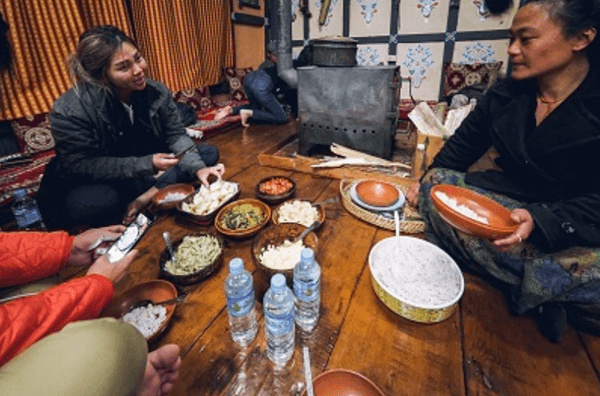
Authentic Bhutanese cuisine:
Folk Heritage Restaurant (Kawajangsa): Serves seasonal local dishes.
Babesa Village Restaurant: Set in a 600-year-old heritage home, offering traditional Bhutanese meals.
Phangu (Taba): Features private themed dining rooms with traditional motifs.
International and fusion options:
Casual dining & fast food:
Indian cuisine hotspot:
Druk Hotel (near Clock Tower): Known for its Indian food, especially the Friday evening buffet featuring breads, curries, and desserts.
Most Popular Bars in Thimphu
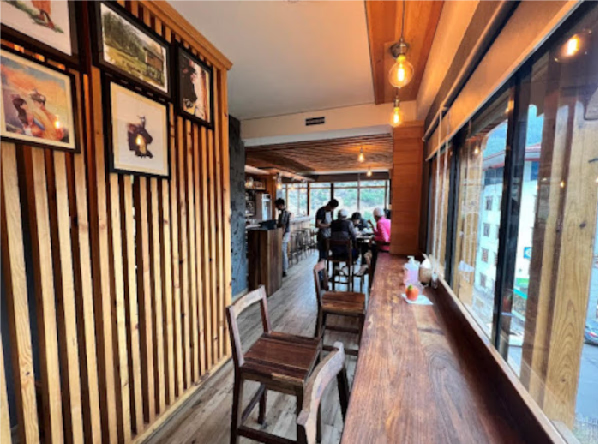
Thimphu's nightlife offers a vibrant mix of traditional Bhutanese drinks and modern cocktails. Here are some of the most popular bars in the city:
Drunken Yeti (opposite My Mart): Renowned for its exceptional cocktails like the 'Moscow Mule' and 'Pina Colada'. For a unique experience, try 'The Yeti', a potent mix of seven spirits, or 'Sildenafil', a saffron-infused ara shot with cordyceps.
Urban Dumra (Lower Changzamtog): Bhutan's first beer garden, offering signature cocktails such as 'Pho Chu Mo Chu' and 'Lychee Dewa'. The spacious venue also hosts beer festivals featuring local brews.
O’ Cafe and Bar (Osel): A daytime café that transforms into a lively bar with events like weekend beer pong tournaments. Signature drinks include 'Si Madrid', 'Stolen Sea Water', and shots like 'Hydeout' and 'Dragon'.
The Alchemy Pub (Changlam): A popular spot among the Gen Z crowd, featuring live performances and karaoke nights. Unique offerings include the 'Syringe Shot', served in a syringe for a distinctive twist.
Riverside Garuda (Changyul Park): Located within the scenic Changyul Park, this bar offers classic drinks like 'Tom Collins' and 'Hot Toddy', perfect for unwinding after a stroll through the rose garden.
Old Factory (Changlam): Boasts an industrial vintage design, serving a variety of snacks and cocktails. Notable drinks include the 'White Lady' and 'Denkar’s Cocktail', named after a popular travel vlogger.
The Grey Area (Hogdzin Lam): An upscale bar adorned with modern décor and art, attracting artists and creatives. The extensive cocktail menu features 'The English Rose', 'The Horny Fawaz', and the 'Gangnam Girls' shot.
Black Sheep Restro Bar (opposite Druk Shopping Complex): One of the few places in Thimphu where you can try authentic 'Tongba', a traditional hot alcoholic beverage made from fermented millet, believed to have therapeutic properties.
The Pema by Realm (Thori Lam): Home to 'The Roof', an open rooftop lounge and bar offering panoramic views of the surrounding mountains. During colder months, guests can enjoy a warm 'Mulled Wine' by the bonfire.
These establishments showcase the dynamic and diverse bar scene in Thimphu, catering to a wide range of preferences and offering unique experiences for both locals and visitors.
Must-Try Traditional Bhutanese Dishes
Ema datshi - A vegetarian dish made of chili and cheese.
Phaksha paa - Sliced pork stir-fried with red chillies.
Phaksha laphu - Stewed pork with radishes.
Yak meat - Fried and served as a snack.
No sha huentse - Stewed beef dish with spinach.
Phaksha phin tshoem - Pork with rice noodles.
Jasha maroo - Chicken in garlic and butter sauce.
Momos - Chicken, pork, beef, cheese, vegetables, or chillies dumplings.
Kewa Datsi - Potatoes with cheese.
Bhathup - Flour noodle soup.
Ezay - A condiment made of onions and chillies with cheese or red chili paste.
Thueb - Porridge made from rice or flat noodles, topped with fried meat.
Fing - Vermicelli or glass noodles that are popularly eaten with meat.
Khur-le – Buckwheat pancakes.
Find out more information about Bhutanese cuisine.
